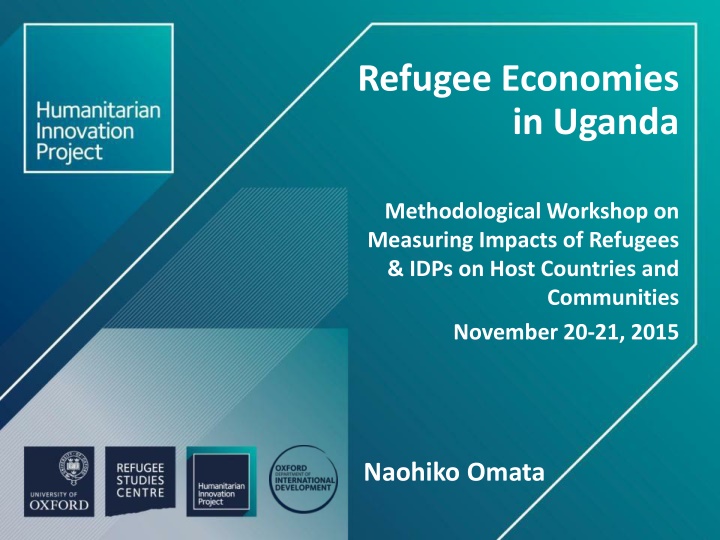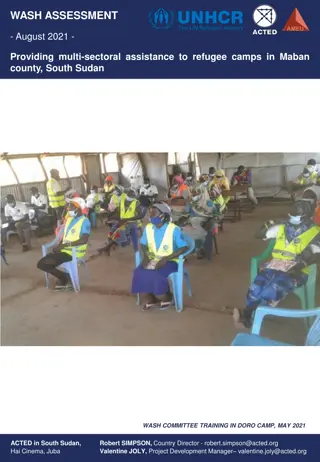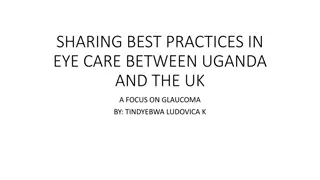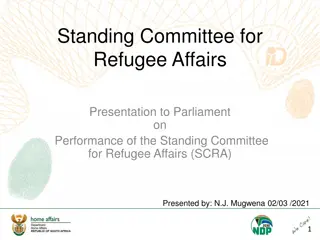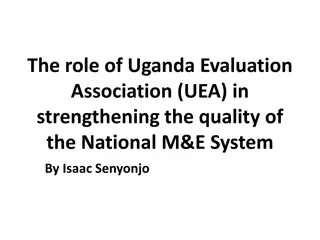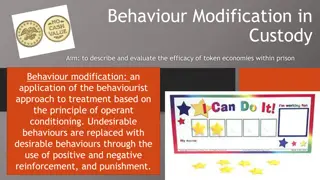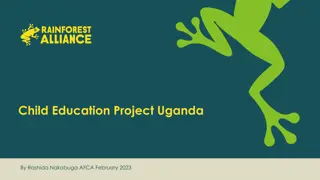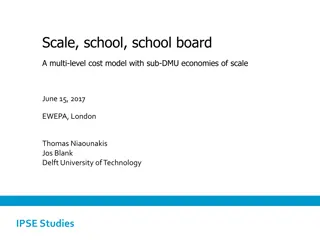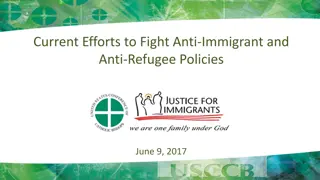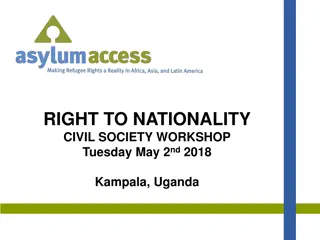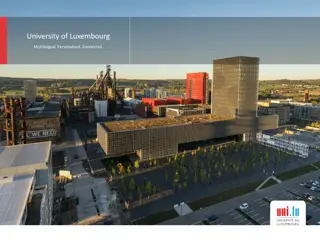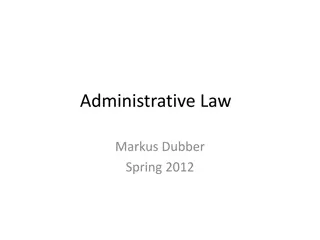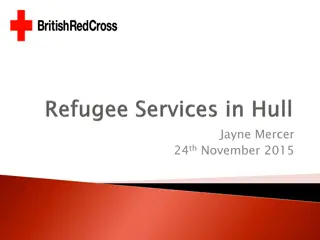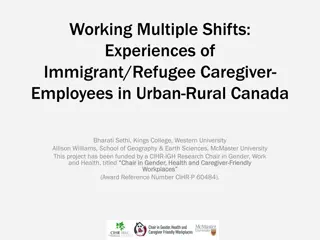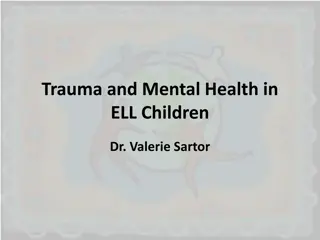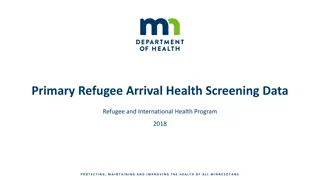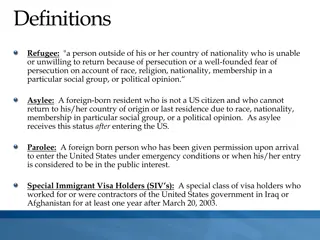Impact Assessment of Refugee Economies in Uganda - Research Workshop Highlights
This document outlines the methodological workshop on measuring the impacts of refugees and IDPs on host countries and communities in Uganda. It focuses on the Humanitarian Innovation Project's research in Uganda, emphasizing the role of innovation, technology, and the private sector in refugee assistance through mixed methods and a participatory approach. The Uganda research team and survey design for exploring refugee economic activities, behaviors, and engagement with the local private sector are also described.
Download Presentation

Please find below an Image/Link to download the presentation.
The content on the website is provided AS IS for your information and personal use only. It may not be sold, licensed, or shared on other websites without obtaining consent from the author.If you encounter any issues during the download, it is possible that the publisher has removed the file from their server.
You are allowed to download the files provided on this website for personal or commercial use, subject to the condition that they are used lawfully. All files are the property of their respective owners.
The content on the website is provided AS IS for your information and personal use only. It may not be sold, licensed, or shared on other websites without obtaining consent from the author.
E N D
Presentation Transcript
Refugee Economies in Uganda Methodological Workshop on Measuring Impacts of Refugees & IDPs on Host Countries and Communities November 20-21, 2015 Naohiko Omata
Humanitarian Innovation Project (HIP) Research project based at RSC, Oxford Initial research focus: understanding the role of innovation, technology and the private sector in refugee assistance Pilot case study across 3 research sites in Uganda between 2012 and 2013 Mixed methods approach: from qualitative to quantitative methods Participatory approach: worked with more than 40 local and refugee research assistants 2
Uganda research team Rashid Mwesigwa Ugandan Research Coordinator Clarissa Tumwine Ugandan Research Coordinator Hope Zainab Natukunda Ugandan Research Coordinator Kampala Nakivale Settlement Kyangwali Settlement Robert Hakiza Ngirwa Congolese RA Abdirahman Sheik Mahi, Somali RA Wardo Omar, Somali RA Osman Somali RA William Bakunzi Congolese RA Ntakamaze Nziyonvira Congolese RA Angelique Kabami Congolese RA Gemus Ngirabakunzi Rwandan RA Hussein Ahmed Abukar, Somali RA Cosomos Lugala S.Sudanese RA Seniya Bekele Ethiopian RA Bernadette Muhongaiyre Burundian RA Sada Faiz Kenyan RA David Bachy Congolese RA Demou-Kay Congolese Filmaker Abdullahi Mahi Somali RA Kiflu Hussain Ethiopian RA Caesar Bishovu Rwandan RA + more than 20 survey enumerators
Survey designing Aim of HIP survey: NOT hypothesis- testing but exploratory Main research questions 1) What types of refugee economic activities and behaviours can be observed in each research site? 2) What kinds of variation in economic outcomes can be observed across refugee households? 3) How do refugees engage with the local private sector through their livelihoods? 4) What roles do innovation and technology play in refugees livelihoods? 4
N = 1,593 surveys across 3 sites with 4 different nationalities Location/target refugee populations Number of registered refugees Target sample number Actual sample number % 507 169 169 169 577 193 181 203 Kampala Total Origin DR Congo Somalia Rwanda Ethiopia Other countries 50,646 23,190 12,662 3,885 1,843 9,066 100% 46% 25% 8% 4% 18% - - - - 629 210 210 210 732 252 237 243 Nakivale Total Origin DR Congo Somalia Rwanda Burundi Eritrea Other countries Kyangwali Total Origin DR Congo South Sudan Other countries 62,849 32,659 11,007 9,452 7,875 1,329 527 20,847 17,681 2,903 263 100% 52% 18% 15% 13% 2% 1% 100% 85% 14% 1% - - - - - - 209 105 105 284 142 142 - 5
3-step sampling: 1) Stratified by refugees country of origin; 2) Randomly selected the villages they live; and 3) Conducted interval sampling in each selected village DR Congo Sub-zone Nyakagando Base Camp Byakatonda Lake view zone Nyarugugu Kisura Byakatonda Juru Kahirimbi Ngarama Ngarama Ngarama Byakatonda Byakatonda Nyarugugu Kashojwa Nyakagando Kabazana Lake view zone Kahirimbi Kisura Nyakagando Lake view zone Ruhoko Lake view zone Kiretwa Kisura Kabahinda Karintima Village Nyakagando A Base Camp II Kankingi A Isanja B Nyarugugu B Kisura C Kankingi C Kajurungusti Kahirimbi A Ngarama A Ngarama B Kakoma Kankingi B Kankingi D Nyarugugu C Kashojwa B Nyakagando B Kabazana A Isanja D Kahirimbi B Rwoma Mirambira Isanja A Ruhoka B Isanja C Kiretwa C Kyeibare B Kityaza B Karintima A 1,978 1,822 1,670 1,289 1,283 995 984 952 883 864 834 822 805 763 753 688 686 653 642 624 568 560 550 546 502 498 487 433 424 1 2 3 4 5 6 7 8 9 10 11 12 13 14 15 16 17 18 19 20 21 22 23 24 25 26 27 28 29 DR Congo St = 241 Sub-zone Village Pv Sv=[Pv/P(tot)]St Nyakagando Base Camp Nyarugugu Juru Ngarama Nyakagando A Base Camp II Nyarugugu B Kajurungusti Ngarama B 1,978 1,822 1,283 952 834 50 46 32 24 21 Lake view zone Isanja D Kahirimbi 642 624 16 16 Kahirimbi B Lake view zone Isanja C Kiretwa Kabahinda 502 498 433 13 13 11 241 Kiretwa C Kityaza B P(tot) 9,568 6
Respondent-Driven Sampling (RDS) Example: RDS Tree for Somali refugees 8
RDS: Asking Social Network Size of Respondents D. Social Network Size Thank you for your patience. This is our final question. D.1 Approximately how many other [refugees of your nationality] do you know? 1. 0 to 5 2. 6 to 10 3. 11 to 20 4. 21 to 50 5. 51 to 100 6. More than 100 Tick only one. If the respondent has trouble specifying a number, promptwith categories. 9
Summary Total survey implementation period: 9 months Involved more than 50 people in this survey project Attempted to do the best with the given conditions Produced reasonably good dataset from 1,600 refugee households Our data: imperfect but valuable (Jacobsen & Landau 2003) 10
